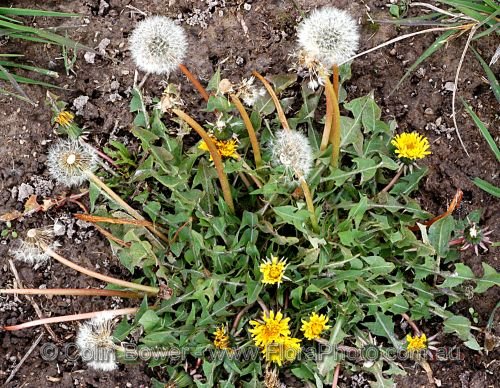Effects: is a diuretic; a mild laxative, increases appetite, improves digestion
Use: It has been used in herbal medicine to treat infections, bile and liver problems. The specific name officinalis refers to its value as a medicinal herb, and is derived from the word opificina, later officina, meaning a workshop or pharmacy. The flowers are used to make dandelion wine, the greens are used in salads, the roots have been used to make a coffee substitute (when baked and ground into powder) and the plant was used by Native Americans as a food and medicine. Dandelion is used in herbal medicine as. The milky latex has been used as a mosquito repellent and as a folk remedy to treat warts
Background information: Dandelions are found on all continents and have been gathered for food since prehistory. The name comes from French dent-de-lion, meaning "lion's tooth" referring to the coarsely toothed leaves. The plant is also known as blowball, cankerwort, doon-head-clock, witch's gowan, milk witch, lion's-tooth, yellow-gowan, Irish daisy, monks-head, priest's-crown and puff-ball;. In several European languages, the plant, or at least its parachute ball stage, is named after the popular children's pastime of blowing the parachutes off the stalk: Pusteblume German for "blowing flower"), soffione (Italian for "blowing", in some northern Italian dialects), dmuchawiec (Polish, derived from the verb "blow"), одуванчик (Russian, derived from the verb "blow")
[wpspoiler name=”Where to find it”]Ireland: The dandelion is a common colonizer of disturbed habitats. In Ireland it is easy to find in fields and on lawns/paths
Germany: Many people see dandelion as a troublesome weed because it grows really everywhere and its great use in kitchen or as remedy is often forgotten.
Greece: It is commonly grown in Greece in open fields.
Poland: It occurs throughout the lowlands and lower parts of the mountain.
Italy: In Italy it grows everywhere until an altitude of 2000 m asl, though mostly in fields, uncultivated areas, and bordering paths and roads.[/wpspoiler]
[wpspoiler name=” Cultural aspects(stories/songs)”] Ireland: The ancient Celts celebrated February 1st as a festival to the White Goddess, whom Christianity later adopted and renamed St.Brigid, and one of her symbols was the Dandelion. The Celts would have used dandelion to treat fever such as malaria and jaundice as dandelion root stimulates the liver. An old wives tale says that if you pick a dandelion before bed you will wet the bed. Dandelion was also known as a cure for warts – 'The juiced of dandelion if rubbed to warts for nine days will destroy them'
Germany: N/A
Greece: Folk Proverb: Whatever is bitter in taste is sweet for the body.
Poland: N/A
Italy: The dandelion was always used in Italy as much in cuisine as in popular medicine. Therapies derived from dandelion leaves or roots is known in Italy as "tarassacoterapia" or “dandelion therapy“.[/wpspoiler]
[wpspoiler name=”Contemporary use(cuisine/ cosmetics/medicine)”]Ireland: The flowers are delicious when dipped in batter and deep-fried. Leaves can be blended with pear, lemon and avocado to make a green sauce
Germany: Dandelion Honey 300g Dandelion flowers, 1kg sugar, 2 lemons, 1l water Only the yellow flower should be used, not the green parts as they are bitter. Slice the lemon. Place the dandelion petals, the water, and the lemon slices in a large pot, stirring to combine. Bring the mixture to a boil, reduce to a fast simmer, and maintain this simmer for 30 minutes. You can allow to steep overnight or can continue directly. Line a colander with cheesecloth and strain the dandelion infusion through it. Afterwards add the sugar and cook 1 hour at low temperature. As variant you can add cloves, a cinnamon stick and 1-2 hands dandelion petals. Mix and it put it at a sunny place. After two weeks fill it in glasses – it helps against cough.
Greece: 1. Reduces cholesterol and decoction of leaves and flowers is used against diabetes and obesity. 2. Gives the maximum benefactions when consumed fresh as salad.
Poland: Diuretic activity nun show particularly extracts from leaves, although this effect is evident also after administration of extracts of the roots.
Italy: The flower petals gives flavour and colour to mixed salads. The buds are consumed after being dressed with olive oil. The flowers can be fried in batter. The flowers are also used in the preparation of jellies, which are often referred to as “dandelion honey”[/wpspoiler]
[wpspoiler name=”Traditional use (remedies, uses)”]Ireland: Dandelion is today used as a great detoxifier, blood cleanser and digestive aid. It strengthens the liver and aids it in breaking down toxins and it also stimulates the kidneys in order for the toxins to be eliminated rapidly. The flow of bile into the intestine stimulated by Dandelion enables better digestion and prevents the formation of gallstones.
Germany: Dandelion always was used as tea but people were also just chewing the leaves. The herbalist Maria Treben (1907 – 1991) recommended to chew up to 10 stems per day especialy for problems with the pancrease, in case of inflammations of the liver, fatigue or also diabetes. The plant stimulates the circulation and strengthens the body´s defence. In poorer times, especially during and after the war, the roots were used as replacement for coffee.
Greece: 1. The best natural diuretic that contains about 5% potassium, which makes it safe to use since it does not "dry out" the body of electrolytes. 2. Liver tonic.
Poland: The roots are used as nun and cholagogum Amarume ESCOP according to the monograph, indicating "to restore the function of the liver and gallbladder, with indigestion, with lack of appetite".
Italy: In Piedmont, the plant was called "sunflower“, and it was traditional to consume it during country family excursions on the day after Easter (i.e. on Pasquetta or “Little Easter“).[/wpspoiler]





